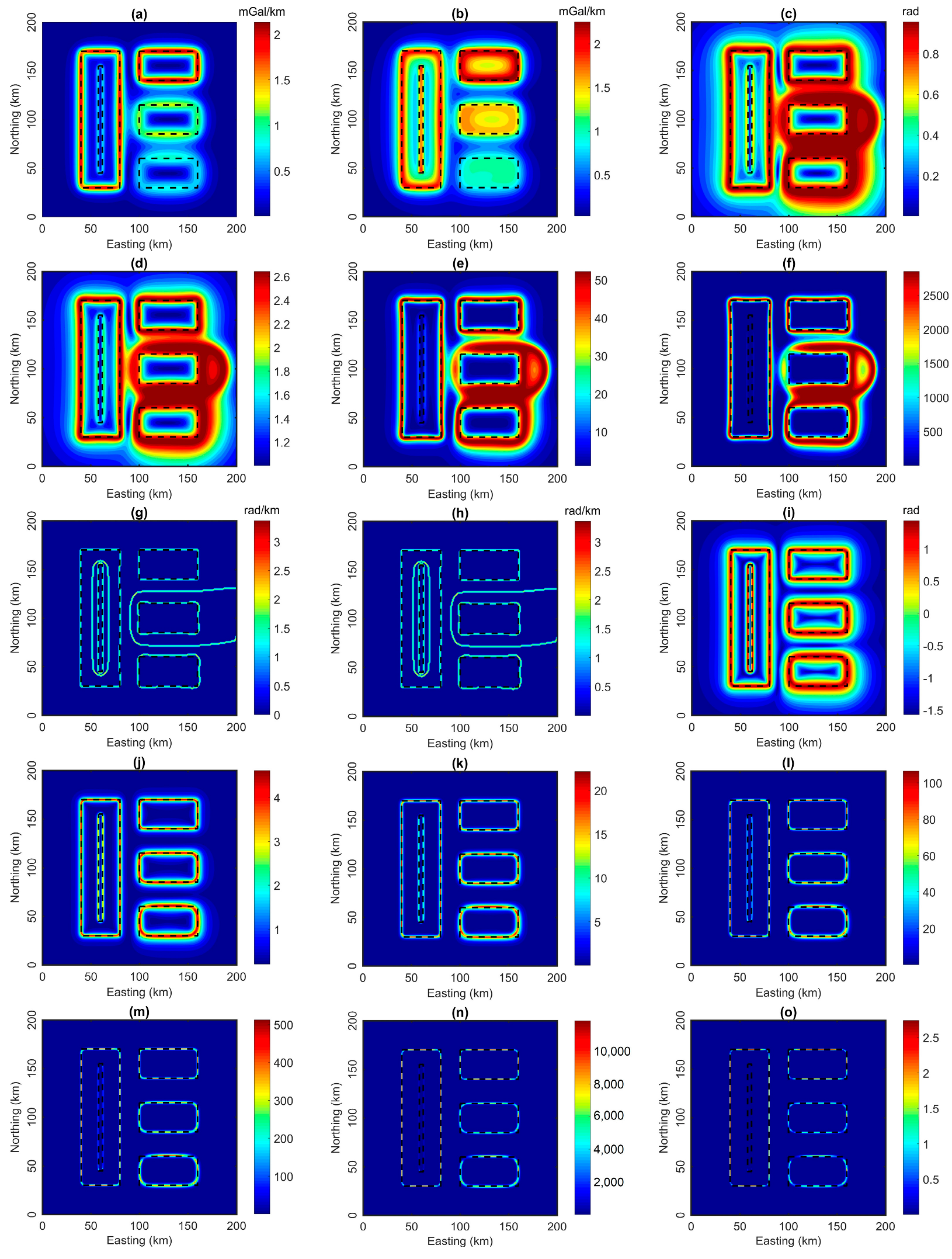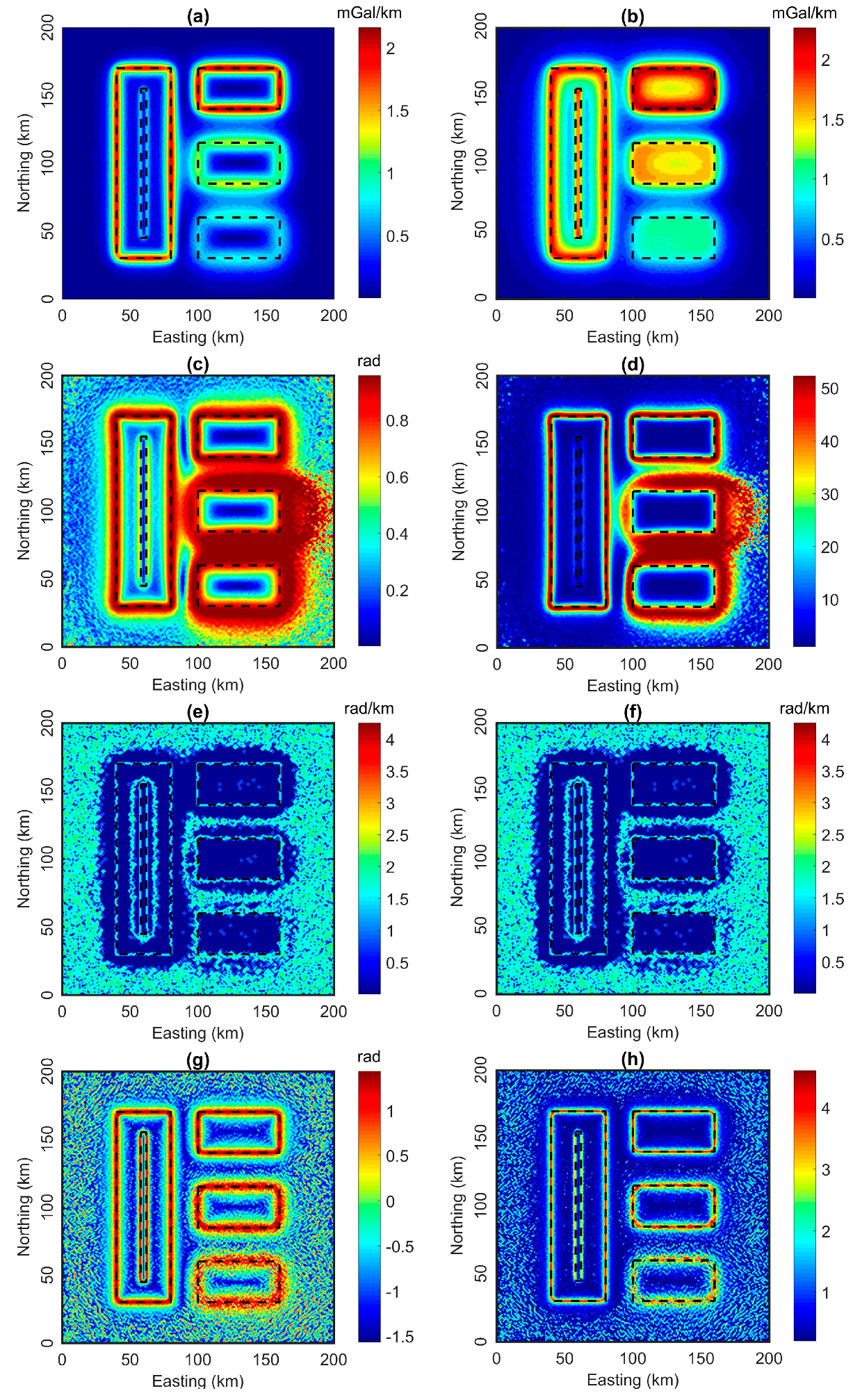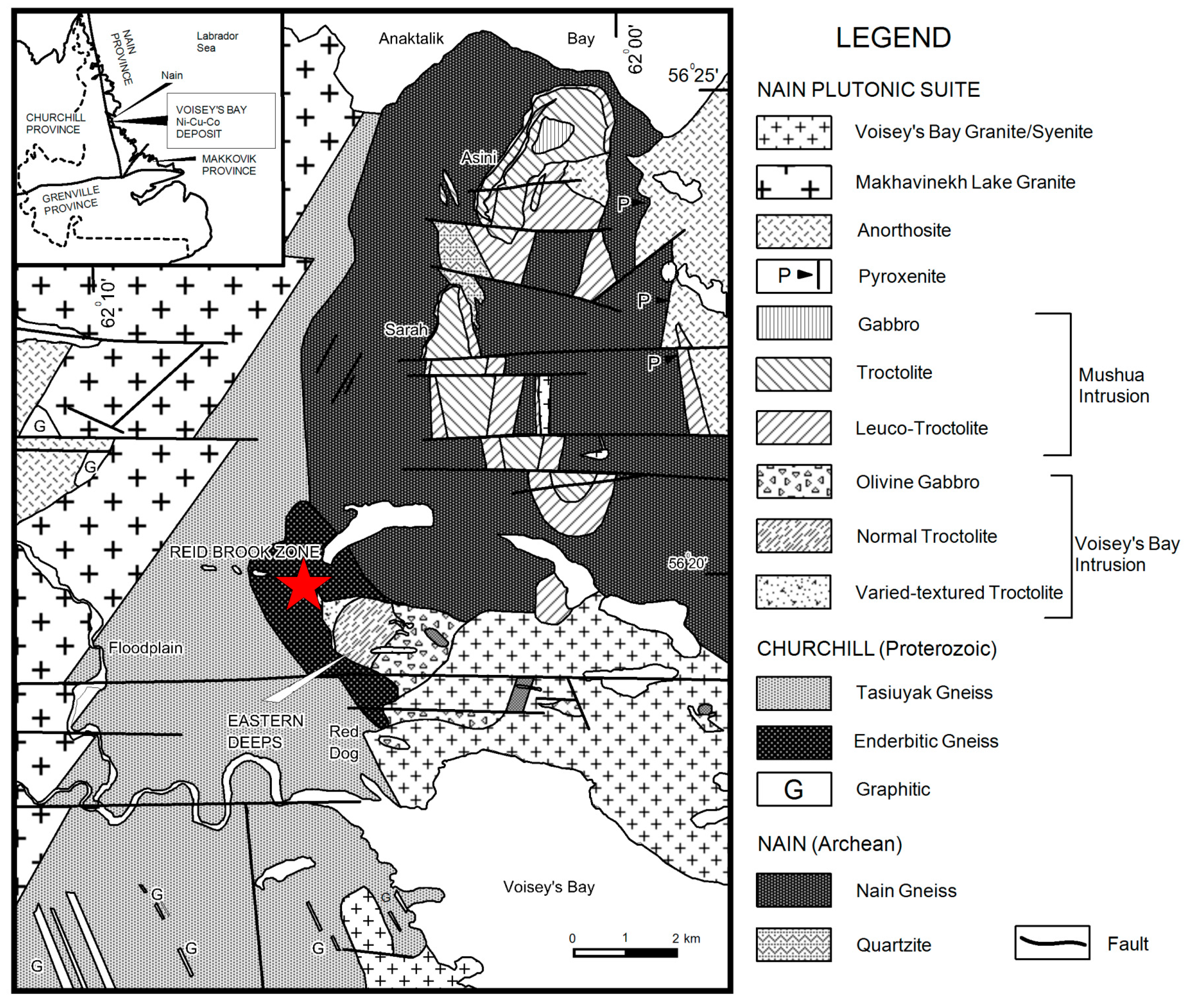Gravity Data Enhancement Using the Exponential Transform of the Tilt Angle of the Horizontal Gradient
Abstract
:1. Introduction
2. Method
3. Methods Used for Comparison
4. Results and Discussion
4.1. Synthetic Examples
4.2. Real Examples
4.2.1. Voisey’s Bay Ni-Cu-Co Deposit
4.2.2. Tuan Giao Area
5. Conclusions
Author Contributions
Funding
Data Availability Statement
Acknowledgments
Conflicts of Interest
References
- Ai, H.; Ekinci, Y.L.; Balkaya, Ç.; Essa, K.S. Inversion of geomagnetic anomalies caused by ore masses using Hunger Games Search algorithm. Earth Space Sci. 2023, 10, e2023EA003002. [Google Scholar] [CrossRef]
- Sampietro, D.; Capponi, M.; Maurizio, G. 3D Bayesian inversion of potential fields: The Quebec Oka carbonatite complex case study. Geosciences 2022, 12, 382. [Google Scholar] [CrossRef]
- Boszczuk, P.; Cheng, L.Z.; Hammouche, H.; Roy, P.; Lacroix, S.; Cheilletz, A. A 3D gravity data interpretation of the Matagami mining camp, Abitibi Subprovince, Superior Province, Québec, Canada: Application to VMS deposit exploration. J. Appl. Geophys. 2011, 75, 77–86. [Google Scholar] [CrossRef]
- Wijanarko, E.; Arisbaya, I.; Sumintadireja, P.; Grandis, H. Magnetotellurics study of Atambua area, West Timor, Indonesia. Vietnam J. Earth Sci. 2022, 45, 67–81. [Google Scholar] [CrossRef] [PubMed]
- Xayavong, V.; Duc, M.V.; Singsoupho, S.; Anh, D.N.; Prasad, K.N.D.; Minh, T.V.; Do Anh, C. Combination of 2D-Electrical Resistivity Imaging and Seismic Refraction Tomography methods for groundwater potential assessments: A case study of Khammouane province, Laos. Vietnam J. Earth Sci. 2023, 45, 238–250. [Google Scholar] [CrossRef] [PubMed]
- Marques, F.; Matos, J.X.; Sousa, P.; Represas, P.; Araujo, A.; Carvalho, J.; Morais, I.; Pacheco, N.; Albardeiro, L.; Goncalves, P. The role of land gravity data in the Neves-Corvo mine discovery and its use in present-day exploration and new target generation. First Break 2019, 37, 97–102. [Google Scholar] [CrossRef]
- Nabighian, M.N.; Ander, M.E.; Grauch, V.J.S.; Hansen, R.O.; LaFehr, T.R.; Li, Y.; Pearson, W.C.; Peirce, J.W.; Phillips, J.D.; Ruder, M.E. Historical development of the gravity method in exploration. Geophysics 2005, 70, 63–89. [Google Scholar] [CrossRef]
- Hinze, W.; Frese, R.; Saad, A. Gravity and Magnetic Exploration: Principles, Practices, and Applications; Cambridge University Press: Cambridge, UK, 2013. [Google Scholar]
- Narayan, S.; Kumar, U.; Pal, S.K.; Sahoo, S.D. New insights into the structural and tectonic settings of the Bay of Bengal using high-resolution earth gravity model data. Acta Geophys. 2021, 69, 2011–2033. [Google Scholar] [CrossRef]
- Narayan, S.; Sahoo, S.D.; Pal, S.K.; Kumar, U. Comparative evaluation of five global gravity models over a part of the Bay of Bengal. Adv. Space Res. 2022, 71, 2416–2436. [Google Scholar] [CrossRef]
- Oksum, E. Grav3CH_inv: A GUI-based MATLAB code for estimating the 3-D basement depth structure of sedimentary basins with vertical and horizontal density variation. Comput. Geosci. 2021, 155, 104856. [Google Scholar] [CrossRef]
- Kamto, P.G.; Oksum, E.; Pham, L.T.; Kamguia, J. Contribution of advanced edge detection filters for the structural mapping of the Douala Sedimentary Basin along the Gulf of Guinea. Vietnam J. Earth Sci. 2023, 45, 287–302. [Google Scholar]
- Narayan, S.; Sahoo, S.D.; Pal, S.K.; Kumar, U.; Pathak, V.K.; Majumdar, T.J.; Chouhan, A. Delineation of structural features over a part of the Bay of Bengal using total and balanced horizontal derivative techniques. Geocarto Int. 2016, 32, 351–366. [Google Scholar] [CrossRef]
- Ekinci, Y.L.; Yigitbas, E. Interpretation of gravity anomalies to delineate some structural features of Biga and Gelibolu peninsulas, and their surroundings (north-west Turkey). Geodin. Acta 2015, 27, 300–319. [Google Scholar] [CrossRef]
- Eldosouky, A.M.; El-Qassas, R.A.Y.; Pham, L.T.; Abdelrahman, K.; Alhumimidi, M.S.; El Bahrawy, A.; Mickus, K.; Sehsah, H. Mapping Main Structures and Related Mineralization of the Arabian Shield (Saudi Arabia) Using Sharp Edge Detector of Transformed Gravity Data. Minerals 2022, 12, 71. [Google Scholar] [CrossRef]
- Melouah, O.; Ebong, E.D.; Abdelrahman, K.; Eldosouky, A.M. Lithospheric structural dynamics and geothermal modeling of the Western Arabian Shield. Sci. Rep. 2023, 13, 11764. [Google Scholar] [CrossRef] [PubMed]
- Kumar, U.; Pal, S.K.; Sahoo, S.D.; Narayan, S.; Saurabh, M.S.; Ganguli, S.S. Lineament mapping over Sir Creek offshore and its surroundings using high resolution EGM2008 gravity data: An integrated derivative approach. J. Geol. Soc. India 2018, 91, 671–678. [Google Scholar] [CrossRef]
- Melouah, O.; Eldosouky, A.M.; Ebong, W.D. Crustal architecture, heat transfer modes and geothermal energy potentials of the Algerian Triassic provinces. Geothermics 2021, 96, 102211. [Google Scholar] [CrossRef]
- Prasad, K.N.D.; Pham, L.T.; Singh, A.P. A novel filter “ImpTAHG” for edge detection and a case study from Cambay Rift Basin, India. Pure Appl. Geophys. 2022, 179, 2351–2364. [Google Scholar] [CrossRef]
- Cooper, G.R.J. Novel Second-Order Derivative-Based Filters for Edge and Ridge/Valley Detection in Geophysical Data. Minerals 2023, 13, 1229. [Google Scholar] [CrossRef]
- Cooper, G.R.J. Amplitude-Balanced Edge Detection Filters for Potential Field Data. Explor. Geophys. 2023, 54, 544–552. [Google Scholar] [CrossRef]
- Kafadar, Ö. Applications of the Kuwahara and Gaussian filters on potential field data. J. Appl. Geophys. 2022, 198, 104583. [Google Scholar] [CrossRef]
- Ekinci, Y.L.; Yiğitbaş, E. A geophysical approach to the igneous rocks in the Biga Peninsula (NW Turkey) based on airborne magnetic anomalies: Geological implications. Geodin. Acta 2012, 25, 267–285. [Google Scholar] [CrossRef]
- Sahoo, S.D.; Narayan, S.; Pal, S.K. Fractal analysis of lineaments using CryoSat-2 and Jason-1 satellite-derived gravity data: Evidence of a uniform tectonic activity over the middle part of the Central Indian Ridge. Phys. Chem. Earth 2022, 128, 103237. [Google Scholar] [CrossRef]
- Yuan, Y.; Yu, Q. Edge detection in potential-field gradient tensor data by use of improved horizontal analytic signal methods. Pure Appl. Geophys. 2015, 172, 461–472. [Google Scholar] [CrossRef]
- Eldosouky, A.M.; Mohamed, H. Edge detection of aeromagnetic data as effective tools for structural imaging at Shilman area, South Eastern Desert, Egypt. Arab. J. Geosci. 2021, 14, 1–10. [Google Scholar] [CrossRef]
- Eldosouky, A.M.; Pham, L.T.; Duong, V.H.; Ghomsi, F.E.K.; Henaish, A. Structural interpretation of potential field data using the enhancement techniques: A case study. Geocarto Int. 2022, 37, 16900–16925. [Google Scholar] [CrossRef]
- Cordell, L. Gravimetric expression of graben faulting in Santa Fe Country and the Espanola Basin. In 30th Field Conference, Socorro, NM, USA, 4–6 October 1979: New Mexico Geological Society Guidebook; New Mexico Geological Society: Socorro, NM, USA, 1979; pp. 59–64. [Google Scholar]
- Roest, W.R.; Verhoef, J.; Pilkington, M. Magnetic interpretation using the 3-D analytic signal. Geophysics 1992, 57, 116–125. [Google Scholar] [CrossRef]
- Fedi, M.; Florio, G. Detection of potential fields source boundaries by enhanced horizontal derivative method. Geophys. Prospect. 2001, 49, 40–58. [Google Scholar] [CrossRef]
- Beiki, M. Analytic signals of gravity gradient tensor and their application to estimate source location. Geophysics 2010, 75, 159–174. [Google Scholar] [CrossRef]
- Alvandi, A.; Ardestani, V.E. Edge detection of potential field anomalies using the Gompertz function as a high-resolution edge enhancement filter. Bull. Geophys. Oceanogr. 2023, 64, 279–300. [Google Scholar]
- Miller, H.G.; Singh, V. Potential field tilt a new concept for location of potential field sources. J. Appl. Geophys. 1994, 32, 213–217. [Google Scholar] [CrossRef]
- Wijns, C.; Perez, C.; Kowalczyk, P. Theta map: Edge detection in magnetic data. Geophysics 2005, 70, 39–43. [Google Scholar] [CrossRef]
- Li, L. Improved edge detection tools in the interpretation of potential field data. Explor. Geophys. 2013, 44, 128–132. [Google Scholar] [CrossRef]
- Cooper, G.; Cowan, D. Enhancing potential field data using filters based on the local phase. Comput. Geosci. 2006, 32, 1585–1591. [Google Scholar] [CrossRef]
- Ferreira, F.J.F.; de Souza, J.; Bongiolo, A.B.S.; de Castro, L.G. Enhancement of the total horizontal gradient of magnetic anomalies using the tilt angle. Geophysics 2013, 78, 33–41. [Google Scholar] [CrossRef]
- Yuan, Y.; Gao, J.Y.; Chen, L.N. Advantages of horizontal directional Theta method to detect the edges of full tensor gravity gradient data. J. Appl. Geophys. 2016, 130, 53–61. [Google Scholar] [CrossRef]
- Nasuti, Y.; Nasuti, A.N. Tilt as an improved enhanced tilt derivative filter for edge detection of potential field anomalies. Geophys. J. Int. 2018, 214, 36–45. [Google Scholar] [CrossRef]
- Zareie, V.; Moghadam, R.H. The application of theta method to potential field gradient tensor data for edge detection of complex geological structures. Pure Appl. Geophys. 2019, 176, 4983–5001. [Google Scholar] [CrossRef]
- Pham, L.T.; Oksum, E.; Do, T.D. Edge enhancement of potential field data using the logistic function and the total horizontal gradient. Acta Geod. Geophys. 2019, 54, 143–155. [Google Scholar] [CrossRef]
- Pham, L.T.; Vu, T.V.; Le, T.S.; Trinh, P.T. Enhancement of potential field source boundaries using an improved logistic filter. Pure Appl. Geophys. 2020, 177, 5237–5249. [Google Scholar] [CrossRef]
- Pham, L.T.; Eldosouky, A.M.; Oksum, E.; Saada, S.A. A new high resolution filter for source edge detection of potential field data. Geocarto Int. 2022, 37, 3051–3068. [Google Scholar] [CrossRef]
- Ibraheem, I.M.; Tezkan, B.; Ghazala, H.; Othman, A.A. A New Edge Enhancement Filter for the Interpretation of Magnetic Field Data. Pure Appl. Geophys. 2023, 180, 2223–2240. [Google Scholar] [CrossRef]
- Ekinci, Y.L.; Ertekin, C.; Yigitbas, E. On the effectiveness of directional derivative based filters on gravity anomalies for source edge approximation: Synthetic simulations and a case study from the Aegean graben system (western Anatolia, Turkey). J. Geophys. Eng. 2013, 10, 035005. [Google Scholar] [CrossRef]
- Pham, L.T.; Oksum, E.; Kafadar, O.; Trinh, P.T.; Nguyen, D.V.; Vo, Q.T.; Le, S.T.; Do, T.D. Determination of subsurface lineaments in the Hoang Sa islands using enhanced methods of gravity total horizontal gradient. Vietnam J. Earth Sci. 2022, 44, 395–409. [Google Scholar]
- Nasuti, Y.; Nasuti, A.; Moghadas, D. STDR: A novel approach for enhancing and edge detection of potential field data. Pure Appl. Geophys. 2019, 176, 827–841. [Google Scholar] [CrossRef]
- Liu, J.; Li, S.; Jiang, S.; Wang, X.; Zhang, J. Tools for Edge Detection of Gravity Data: Comparison and Application to Tectonic Boundary Mapping in the Molucca Sea. Surv. Geophys. 2023, 44, 1781–1810. [Google Scholar] [CrossRef]
- Farquharson, C.G.; Ash, M.R.; Miller, H.G. Geologically constrained gravity inversion for the Voisey’s Bay ovoid deposit. Lead. Edge 2008, 27, 64–69. [Google Scholar] [CrossRef]
- Li, C.; Naldrett, A. Geology and petrology of the Voisey’s Bay intrusion: Reaction of olivine with sulfide and silicate liquids. Lithos 1999, 47, 1–31. [Google Scholar] [CrossRef]
- Ryan, B. Geological Map of the Nain Plutonic Suite and Surrounding Rocks Nain-Nutak, NTS 14SW. Geological Survey Branch, Newfoundland Department of Mines and Energy, Scale 1:500,000; Government of Newfoundland and Labrador: St. John’s, NL, Canada, 1990.
- King, A. Review of Geophysical Technology for Ni-Cu-PGE deposits. In Proceedings of the Exploration 07: Fifth Decennial International Conference on Mineral Exploration, Toronto, ON, Canada, 9–12 September 2007; Milkereit, B., Ed.; CVRD Exploration Canada Inc.: Cliff, ON, Canada, 2007; pp. 647–665. [Google Scholar]
- Lelièvre, P.; Carter-McAuslan, A.; Farquharson, C.; Hurich, C. Unified geophysical and geological 3D Earth models. Lead. Edge 2012, 31, 322–328. [Google Scholar] [CrossRef]
- Duong, N.A.; Sagiya, T.; Kimata, F.; Tran, D.T.; Vy, Q.H.; Cong, D.C.; Binh, N.X.; Xuyen, N.D. Contemporary horizontal crustal movement estimation for northwestern Vietnam inferred from repeated GPS measurements. Earth Planets Space 2013, 65, 1399–1410. [Google Scholar] [CrossRef]
- Zhou, M.F.; Chen, W.T.; Wang, C.Y.; Prevec, S.A.; Liu, P.P.; Howarth, G.H. Two stages of immiscible liquid separation in the formation of Panzhihua-type Fe–Ti–V oxide deposits, SW China. Geosci. Front. 2013, 4, 481–502. [Google Scholar] [CrossRef]
- Roger, F.; Maluski, H.; Lepvrier, C.; Van, T.V.; Paquette, J.-L. LA-ICPMS zircons U/Pb dating of Permo-Triassic and Cretaceous magmatisms in Northern Vietnam–Geodynamical implications. J. Asian Earth Sci. 2012, 48, 72–82. [Google Scholar] [CrossRef]
- Tran, T.A.; Tran-Trong, H.; Pham-Ngoc, C.; Shellnutt, J.G.; Pham, T.T.; Izokh, A.E.; Pham, P.L.T.; Duangpaseuth, S.; Soulintone, O. Petrology of the Permian-Triassic granitoids in Northwest Vietnam and their relation to the amalgamation of the Indochina and Sino-Vietnam composite terranes. Vietnam J. Earth Sci. 2022, 44, 343–368. [Google Scholar] [CrossRef] [PubMed]
- Pham, L.T. A comparative study on different methods for calculating gravity effect of an uneven layer: Application to computation of Bouguer gravity anomaly in the East Vietnam Sea and adjacent areas. VNU J. Sci. Math Phys. 2020, 36, 106–114. [Google Scholar]










| Parameters | P1 | P2 | P3 | P4 | P5 |
|---|---|---|---|---|---|
| Center coordinates (km; km) | 60; 100 | 60; 100 | 130; 155 | 130; 100 | 130; 45 |
| Width (km) | 4 | 40 | 30 | 30 | 30 |
| Length (km) | 110 | 140 | 60 | 60 | 60 |
| Depth of top (km) | 2 | 3 | 3 | 6 | 9 |
| Depth of bottom (km) | 3 | 5 | 7 | 10 | 13 |
| Density contrast (g/cm3) | 0.2 | 0.3 | 0.2 | −0.2 | 0.2 |
Disclaimer/Publisher’s Note: The statements, opinions and data contained in all publications are solely those of the individual author(s) and contributor(s) and not of MDPI and/or the editor(s). MDPI and/or the editor(s) disclaim responsibility for any injury to people or property resulting from any ideas, methods, instructions or products referred to in the content. |
© 2023 by the authors. Licensee MDPI, Basel, Switzerland. This article is an open access article distributed under the terms and conditions of the Creative Commons Attribution (CC BY) license (https://creativecommons.org/licenses/by/4.0/).
Share and Cite
Pham, L.T.; Oliveira, S.P.; Le, C.V.A.; Bui, N.T.; Vu, A.H.; Nguyen, D.A. Gravity Data Enhancement Using the Exponential Transform of the Tilt Angle of the Horizontal Gradient. Minerals 2023, 13, 1539. https://doi.org/10.3390/min13121539
Pham LT, Oliveira SP, Le CVA, Bui NT, Vu AH, Nguyen DA. Gravity Data Enhancement Using the Exponential Transform of the Tilt Angle of the Horizontal Gradient. Minerals. 2023; 13(12):1539. https://doi.org/10.3390/min13121539
Chicago/Turabian StylePham, Luan Thanh, Saulo Pomponet Oliveira, Cuong Van Anh Le, Nhung Thi Bui, An Hoa Vu, and Duong Anh Nguyen. 2023. "Gravity Data Enhancement Using the Exponential Transform of the Tilt Angle of the Horizontal Gradient" Minerals 13, no. 12: 1539. https://doi.org/10.3390/min13121539






